
Concept explainers
(a)
Interpretation:
For the given molecule, the complete IUPAC name is to be written.
Concept introduction:
To write the IUPAC name, first, it is important to determine the highest-priority functional group present that requires a suffix referring to Table E-1. For the molecules having two or more highest-priority
The main chain or ring containing the highest-priority functional group is to be determined. The next step is to number the main chain or ring such that carbon atoms involving highest-priority functional group receive the lowest possible numbers. The locator number for the highest-priority functional group is written immediately before the suffix unless needed. All other functional groups in the molecule are treated as substituents and appear in the name as a prefix. Prefixes such as ‘di’, ‘tri’, ‘tetra’... etc. are used to indicate the number of identical substituents attached. The substituents are named in alphabetical order.
In the IUPAC name of the molecule, the stereochemical configurations at the chiral centers are included as R/S. When assigning priorities to substituents, the atom having the greater
When the fourth priority substituent is pointing away (it is attached by a dash bond) and the first, second, and third priority substituents are arranged clockwise, the configuration is R.
When the fourth priority substituent is pointing away (it is attached by a dash bond) and the first, second, and third priority substituents are arranged counterclockwise, the configuration is S.
If the fourth priority substituent is attached by a wedge bond, then the clockwise or counterclockwise arrangement of the first, second, and third priority substituents is determined and that arrangement is reversed before assigning R or S.
If the fourth priority substituent is in the plane of the page, then it is switched with the substituent that points away. Then, the clockwise or counterclockwise arrangement of the first, second, and third priority substituents is determined, and that arrangement is reversed before assigning R or S.
When writing the IUPAC name, the R or S designation is written in parenthesis for each asymmetric carbon atom and hyphens are used to separate those designations from the rest of the IUPAC name.
Answer to Problem E.32P
The complete IUPAC name for the given molecule, considering the given stereochemistry, is
Explanation of Solution
The given molecule is:
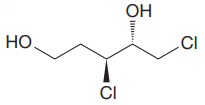
The molecule above contains two
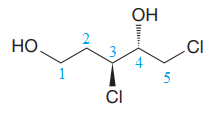
The corresponding locator numbers are also added before the prefix ‘di’. Thus, the name of the root is
There are two chiral centers in the given molecule at C3 and C4 carbon atoms.
The C3 carbon attached to Chlorine atom by a wedge bond has the S configuration, while the C4 carbon attached to the
The complete IUPAC name for the given molecule considering the given stereochemistry
is written above.
(b)
Interpretation:
For the given molecule, the complete IUPAC name is to be written.
Concept introduction:
To write the IUPAC name, first, it is important to determine the highest-priority functional group present that requires a suffix referring to Table E-1. For the molecules having two or more highest-priority functional groups, the rules are slightly different. In the IUPAC name of such molecules, the final ‘e’ of ‘ane’, ‘ene’, or ‘yne’ is not removed in the suffix. Prefixes such as ‘di’, ‘tri, etc are written immediately before the suffix to specify the number of highest-priority functional groups. Add a locator number for each of the highest-priority functional groups immediately before the prefixes.
The main chain or ring containing the highest-priority functional group is to be determined. The next step is to number the main chain or ring such that carbon atoms involving the highest-priority functional group receive the lowest possible numbers. The locator number for the highest-priority functional group is written immediately before the suffix unless needed. All other functional groups in the molecule are treated as substituents and appear in the name as a prefix. Prefixes such as ‘di’, ‘tri’, ‘tetra’… etc. are used to indicate the number of identical substituents attached. The substituents are named in alphabetical order.
In the IUPAC name of the molecule, the stereochemical configurations at the chiral centers are included as R/S. When assigning priorities to substituents, the atom having the greater atomic number has higher priority.
When the fourth priority substituent is pointing away (it is attached by a dash bond) and the first, second, and third priority substituents are arranged clockwise, the configuration is R.
When the fourth priority substituent is pointing away (it is attached by a dash bond) and the first, second, and third priority substituents are arranged counterclockwise, the configuration is S.
If the fourth priority substituent is attached by a wedge bond, then the clockwise or counterclockwise arrangement of the first, second, and third priority substituents is determined and that arrangement is reversed before assigning R or S.
If the fourth priority substituent is in the plane of the page, then it is switched with the substituent that points away. Then, the clockwise or counterclockwise arrangement of the first, second, and third priority substituents is determined and that arrangement is reversed before assigning R or S.
When writing the IUPAC name, the R or S designation is written in parenthesis for each asymmetric carbon atom, and hyphens are used to separate those designations from the rest of the IUPAC name.
Answer to Problem E.32P
The complete IUPAC name for the given molecule is
Explanation of Solution
The given molecule is:
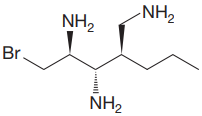
The molecule above contains three

The corresponding locator numbers are also added before the prefix ‘tri’. Thus, the name of the root is
The carbon atoms C2 and C3 have two substituents attached.
One propyl group is attached to the C2 carbon atom of the root, while one bromine atom is attached to the C5 carbon atom of the root. The substituents are named in alphabetical order.
Thus, the complete IUPAC name for the compound without considering the stereochemistry is
There are three chiral centers in the given molecule.
The C2 carbon atom has R configuration.
The C3 carbon attached to
The C4 carbon attached to
Thus, the IUPAC name of the compound, considering the given stereochemistry is,
The complete IUPAC name for the given molecule considering the given stereochemistry
is written above.
(c)
Interpretation:
For the given molecule, the complete IUPAC name is to be written.
Concept introduction:
To write the IUPAC name, first, it is important to determine the highest-priority functional group present that requires a suffix referring to Table E-1. For the molecules having two or more highest-priority functional groups, the rules are slightly different. In the IUPAC name of such molecules, the final ‘e’ of ‘ane’, ‘ene’, or ‘yne’ is not removed in the suffix. Prefixes such as ‘di’, ‘tri, etc are written immediately before the suffix to specify the number of highest-priority functional groups. Add a locator number for each of the highest-priority functional groups immediately before the prefixes.
The main chain or ring is to be determined to be the one that contains the highest-priority functional groups. The next step is to number the main chain or ring such that carbon atoms involving highest-priority functional group receives the lowest possible numbers. The locator number for the highest-priority functional group is written immediately before the suffix unless needed. All other functional groups in the molecule are treated as substituents and appear in the name as a prefix. Prefixes such as ‘di’, ‘tri’, ‘tetra’… etc. are used to indicate the number of identical substituents attached. The substituents are named in alphabetical order.
In the IUPAC name of the molecule, the stereochemical configurations at the chiral centers are included as R/S. When assigning priorities to substituents, the atom having the greater atomic number has higher priority.
When the fourth priority substituent is pointing away (it is attached by a dash bond) and the first, second, and third priority substituents are arranged clockwise, the configuration is R.
When the fourth priority substituent is pointing away (it is attached by a dash bond) and the first, second, and third priority substituents are arranged counterclockwise, the configuration is S.
If the fourth priority substituent is attached by a wedge bond, then the clockwise or counterclockwise arrangement of the first, second, and third priority substituents is determined and that arrangement is reversed before assigning R or S.
If the fourth priority substituent is in the plane of the page, then it is switched with the substituent that points away. Then, the clockwise or counterclockwise arrangement of the first, second, and third priority substituents is determined and that arrangement is reversed before assigning R or S.
When writing the IUPAC name, the R or S designation is written in parenthesis for each asymmetric carbon atom and hyphens are used to separate those designations from the rest of the IUPAC name.
Answer to Problem E.32P
The complete IUPAC name for the given molecule is
Explanation of Solution
The given molecule is:
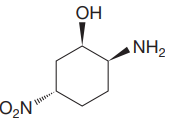
The molecule above contains one
The numbering is shown below:
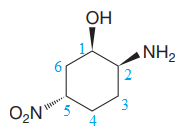
The name of the root is
There is one
Thus, the complete IUPAC name without considering the stereochemistry for the compound is
There are three chiral centers in the molecule.
The C1 carbon atom attached to the
The C2 carbon attached to the
The C5 carbon attached to the
Thus, the IUPAC name of the compound considering the given stereochemistry is
The complete IUPAC name for the given molecule considering the given stereochemistry
is written above.
Want to see more full solutions like this?
Chapter E Solutions
Organic Chemistry: Principles and Mechanisms (Second Edition)
- Identify the unknown compound from its IR and proton NMR spectra. C4H6O: 'H NMR: 82.43 (1H, t, J = 2 Hz); 8 3.41 (3H, s); 8 4.10 (2H, d, J = 2 Hz) IR: 2125, 3300 cm¹ The C4H6O compound liberates a gas when treated with C2H5 MgBr. Draw the unknown compound. Select Draw с H Templates Morearrow_forwardPlease help with number 6 I got a negative number could that be right?arrow_forward1,4-Dimethyl-1,3-cyclohexadiene can undergo 1,2- or 1,4-addition with hydrogen halides. (a) 1,2-Addition i. Draw the carbocation intermediate(s) formed during the 1,2-addition of hydrobromic acid to 1,4-dimethyl-1,3-cyclohexadiene. ii. What is the major 1,2-addition product formed during the reaction in (i)? (b) 1,4-Addition i. Draw the carbocation intermediate(s) formed during the 1,4-addition of hydrobromic acid to 1,4-dimethyl-1,3-cyclohexadiene. ii. What is the major 1,4-addition product formed from the reaction in (i)? (c) What is the kinetic product from the reaction of one mole of hydrobromic acid with 1,4-dimethyl-1,3-cyclohexadiene? Explain your reasoning. (d) What is the thermodynamic product from the reaction of one mole of hydrobro-mic acid with 1,4-dimethyl-1,3-cyclohexadiene? Explain your reasoning. (e) What major product will result when 1,4-dimethyl-1,3-cyclohexadiene is treated with one mole of hydrobromic acid at - 78 deg * C ? Explain your reasoning.arrow_forward
- Give the product of the bimolecular elimination from each of the isomeric halogenated compounds. Reaction A Reaction B. КОВ CH₂ HotBu +B+ ко HOIBU +Br+ Templates More QQQ Select Cv Templates More Cras QQQ One of these compounds undergoes elimination 50x faster than the other. Which one and why? Reaction A because the conformation needed for elimination places the phenyl groups and to each other Reaction A because the conformation needed for elimination places the phenyl groups gauche to each other. ◇ Reaction B because the conformation needed for elimination places the phenyl groups gach to each other. Reaction B because the conformation needed for elimination places the phenyl groups anti to each other.arrow_forwardFive isomeric alkenes. A through each undergo catalytic hydrogenation to give 2-methylpentane The IR spectra of these five alkenes have the key absorptions (in cm Compound Compound A –912. (§), 994 (5), 1643 (%), 3077 (1) Compound B 833 (3), 1667 (W), 3050 (weak shoulder on C-Habsorption) Compound C Compound D) –714 (5), 1665 (w), 3010 (m) 885 (3), 1650 (m), 3086 (m) 967 (5), no aharption 1600 to 1700, 3040 (m) Compound K Match each compound to the data presented. Compound A Compound B Compound C Compound D Compoundarrow_forward7. The three sets of replicate results below were accumulated for the analysis of the same sample. Pool these data to obtain the most efficient estimate of the mean analyte content and the standard deviation. Lead content/ppm: Set 1 Set 2 Set 3 1. 9.76 9.87 9.85 2. 9.42 9.64 9.91 3. 9.53 9.71 9.42 9.81 9.49arrow_forward
- Draw the Zaitsev product famed when 2,3-dimethylpentan-3-of undergoes an El dehydration. CH₂ E1 OH H₁PO₁ Select Draw Templates More QQQ +H₂Oarrow_forwardComplete the clean-pushing mechanism for the given ether synthesia from propanol in concentrated sulfurica140°C by adding any mining aloms, bands, charges, nonbonding electron pairs, and curved arrows. Draw hydrogen bonded to cayan, when applicable. ore 11,0 HPC Step 1: Draw curved arrows Step 2: Complete the intend carved Q2Q 56 QQQ Step 3: Complete the intermediate and add curved Step 4: Modify the structures to draw the QQQ QQQarrow_forward6. In an experiment the following replicate set of volume measurements (cm3) was recorded: (25.35, 25.80, 25.28, 25.50, 25.45, 25.43) A. Calculate the mean of the raw data. B. Using the rejection quotient (Q-test) reject any questionable results. C. Recalculate the mean and compare it with the value obtained in 2(a).arrow_forward
- A student proposes the transformation below in one step of an organic synthesis. There may be one or more reactants missing from the left-hand side, but there are no products missing from the right-hand side. There may also be catalysts, small inorganic reagents, and other important reaction conditions missing from the arrow. • Is the student's transformation possible? If not, check the box under the drawing area. • If the student's transformation is possible, then complete the reaction by adding any missing reactants to the left-hand side, and adding required catalysts, inorganic reagents, or other important reaction conditions above and below the arrow. • You do not need to balance the reaction, but be sure every important organic reactant or product is shown. + T G OH де OH This transformation can't be done in one step.arrow_forwardMacmillan Leaming Draw the major organic product of the reaction. 1. CH3CH2MgBr 2. H+ - G Select Draw Templates More H о QQarrow_forwardDraw the condensed structure of 3-hydroxy-2-butanone. Click anywhere to draw the first atom of your structure.arrow_forward
